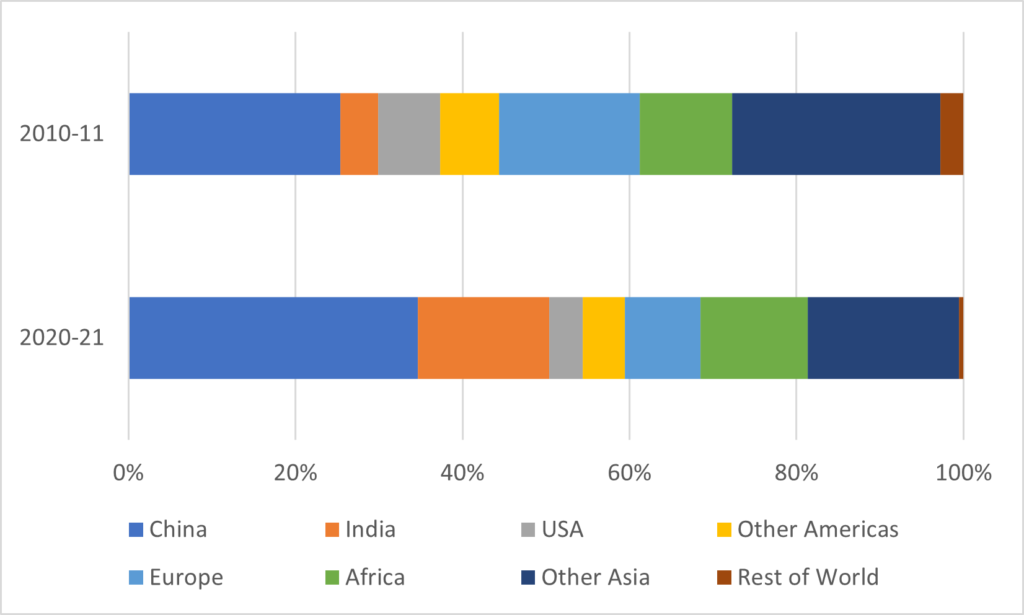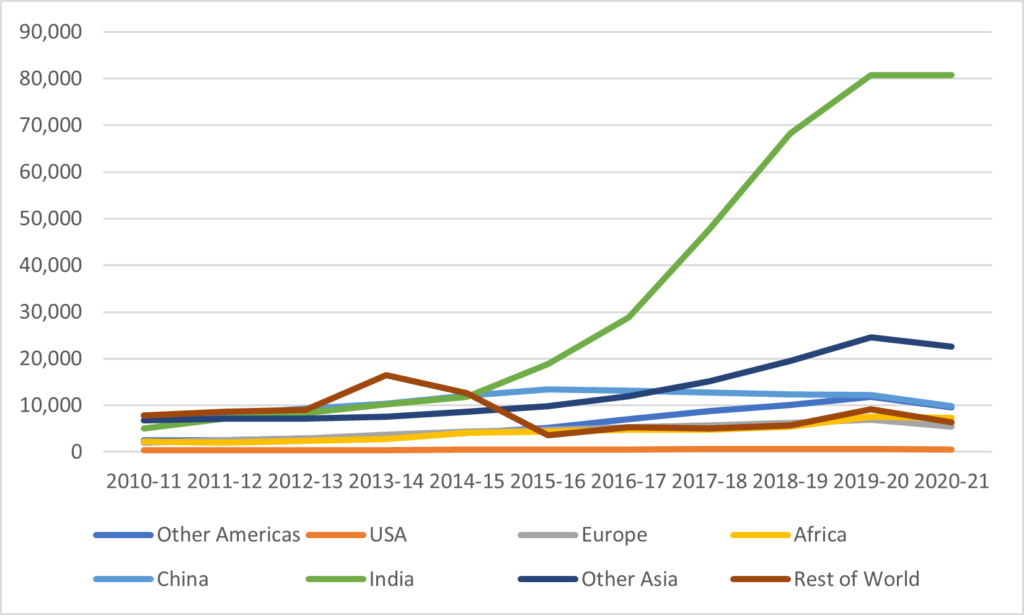Yesterday, we looked at what and where international students studied in Canada. Today, I want to zero in a bit on where international students are from.
Let’s start with the issue of country of origin. Care is required because the data gets a bit tricky: there are something like 135,000 students in Canada who are of dual origin. They are Canadian students, but they also have citizenship in another country. In this post I will focus on the nation or region of origin of students without Canadian citizenship.
Figure 1 shows the evolution of international students in universities by country or region of origin since 2010. Region is generally preferred to country in this graph because while there are some countries with impressive increases over the past few years (Bangladesh in particular), their starting levels are not legible on a graph of this size. As can easily be seen, most of the increase in international students in this sector come from two countries: China and India, with the former predominating. The region which took the biggest hit during COVID was Europe, not any of the Asian countries.
Figure 1: International Student Enrolments by Country/Region of Origin, Canadian Universities, 2010-11 to 2020-21

Turning to shares of enrolments, China and India have expanded their share of university enrolments enormously. The African continent, where growth has been mostly evenly divided between sub-Saharan Africa and the Arab states along the Mediterranean, has also seen significant growth. In 2020-21, India and China together made up 51% of international student enrolments in Canadian universities, up from just 30% a decade earlier.
Figure 2: Share of International Student Enrolment by Country/Region, Canadian Universities, 2010-11 vs. 2020-21

It is a very different story in colleges, where nearly all the recent growth comes from India. This graph would look even more lopsided if we included the last two years <insert usual rant about the lackadaisical Canadian attitude to education data>. Other countries have increased enrolment, particularly students from south-east Asia, but it all fades compared to the impact of Indian students, many of whom are here as much for the possibility of immigration as for any educational credential.
Figure 3: International Student Enrolments by Country/Region of Origin, Canadian Colleges, 2010-11 to 2020-21

Examining shares of international enrolment changing over a decade, as shown in Figure 4, puts the trend in sharp relief. Despite rising absolute numbers, China has gone from accounting for 23% of international community college students in 2010-11 to just 7% today. Why? Because numbers from India rose 16-fold, thus growing from 15% to 57% of the total in just a decade.
Figure 4: Share of International Student Enrolment by Country/Region, Canadian Colleges, 2010-11 vs. 2020-21

If you are wondering why “rest of the world” was so big in 2010, it’s not because we had a huge influx of people from Oceania or anything, it’s just that as late as 2010, a lot of Canadian colleges simply didn’t record international students’ place of origin.
Figure 5 combines the data from figures 2 and 4 to contrast what is happening in the college and university sectors. In colleges, it is India that predominates; in universities, it is China, although to a much lesser extent. “Other Asia” – mainly Korea, Vietnam, and Bangladesh – makes up 16-18% of enrolments in both sectors. African, American, and European students are mostly concentrated in the university sector.
Figure 5: Share of International Student Enrolment by Country/Region, Canadian Universities vs. Colleges, 2020-21

As a final point, international students as a group are disproportionately men compared to domestic students. As figure 6 shows, domestic students at Canadian universities are about 60% women, while among international students it is under 50%. This suggests that a significant part of the reason that overall university gender ratios have stopped increasing in women’s favour is because of rising international student enrolments. Figure 7 shows a similar picture for colleges, with the difference being that there is one group of students, namely those from Latin America and the Caribbean, where women are more prevalent than among the domestic student population. In both sectors, it is students from India where women have the smallest share of enrolments.
Figure 6: Female Share of Enrolment by National Origin, Canadian Universities 2020-21

Figure 7: Female Share of Enrolment by National Origin, Canadian Colleges 2020-21

There you have it: international students in universities tilt male, are increasingly from China, and study in a variety of disciplines, with some preference towards science, engineering, and business. International students in colleges tilt male, are to an increasing degree overwhelmingly from India, and cluster to an extraordinary degree in business programs. Probably not anything you didn’t know already, but now you have the stats to go with it.

 Tweet this post
Tweet this post

Hi Alex
This is Avtar from ‘Vasda Punjab ‘web based channel .. can we refer graphs shared by you in our YouTube video … These are so easier to understand . We will use Punjabi language to interpret them.
Thanks and Regards
Avtar
This is a really well-written and fascinating article, and I like that you tried to include relevant details. Your writing is legible, engaging, and clear, and your careful research shows that you are well-versed in the subject. This is a great useful resource for anyone who wants to learn more about the topic.